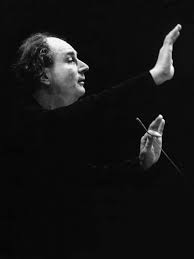쿠벨릭은 명바이올리니스트 얀 쿠벨릭의 아들로 태어나 어렸을 때부터 음악적 재능을 발휘해 프라하 음악원 졸업 후 일찌감치 주목을 받았는데, 1936년에 어린 나이로 체코 필의 지휘 무대에 서고 1941 년에는 수석 지휘자가 되었다. 1939년부터는 부르노 가극장의 음악 감독도 역임하는(1941년까지) 등 체코의 젊은 지휘자로서 다양한 경험을 쌓아 나갔다. 1946년에 시작된 <프라하의 봄> 음악제 첫 회 콘서트를 지휘했던 사람이 당시 32세였던 쿠벨릭이었다.

그러나 1948년 공산당 독재가 성립되자 쿠벨릭은 조국을 떠나(쿠벨릭의 국적은 스위스로 되어 있다) 국제 활동을 시작했다. 쿠벨릭은 1950년에서 1953년 사이에 시카고 심포니 오케스트라의 음악 감독, 1955년에서 1958년에는 코벤트가든 왕립 가극장 관현악단의 음악 감독, 그리고 1961년에는 은퇴할 때까지 지휘를 맡았던 바이에른 방송 교향악단의 수석 지휘자로 취임한다. 그 밖에 빈 필하모니 오케스트라, 빈 심포니 오케스트라, 베를린 필하모니 오케스트라 등 세계적인 오케스트라를 지휘하고 음반을 냈다.
쿠벨릭의 레퍼토리는 근본적으로는 독일 오스트리아계 작곡가 중심이나 스메타나, 드보르작, 야나체크 같은 체코 작곡가도 중요하게 다루고 있다. 또한 오스트리아 작곡가라 해도 말러처럼 근본이 보헤미아에 있는 작가에게 특히 무게를 두고 있으며 특히 드보르작이나 말러에 대해서는 각기 교향곡 전집을 녹음해서 높은 평가를 받고 있다. 그리고 그 두 작곡가의 작품 연주 스타일에는 체코에 자신의 근원을 두는 지휘자로서 쿠벨릭의 특질이 잘 나타나 있다고 말할 수 있다.
베를린 필과 연주하고 있는 드보르작 교향곡 전집 녹음을 보면 그것을 잘 알 수 있다. 예를 들면 교향곡 제9번 「신세계」를 같은 70년대에 카라얀이 지휘하여 녹음한 음반(EMI)과 비교하면 그 특징과 차이가 확실하게 나타난다. 카라얀(1908~1989)은 베를린 필을 지휘하여 세련되고 장렬하며 박력 있는 음을 만들어 냈는데, 「신세계」가 마치 바그너나 브루크너의 작품인가 싶을 정도로 장대한 스케일로 연주하고 있다. 이것은 일반적인 의미의 오케스트라 작품으로서 듣는다면 하나의 해석으로 납득할 수 있고 이것만큼 통쾌하고 멋진 연주는 없다. 그러나 거기에서는 보헤미아라는 지역이 가지는 고유의 운치를 찾을 수는 없다.
그런 관점에서 보면 쿠벨릭이 만들어 내는 음의 세계는 베를린 필에서 너무 중후하지도 않고 너무 가볍지도 않은 적당한 긴장감을 유지한 음을 끌어내면서 작품을 무리 없이 만들어 가고 있다. 또한 주제, 동기 등의 선율의 리듬감이 확실하고 소박한 반복 부분, 악센트가 명료한 춤곡 스타일의 리듬 등은 순수하고 향수 어린 분위기를 적당히 가미해 이 작품이 미국의 영향을 받았으면서도 본질적으로는 보헤미아의 정서를 다분히 포함하고 있다는 것을 분명히 하고 있다.
또한 단순히 전원적인 표현만을 드러내는 것이 아니라 억제할 곳은 억제해서 악보를 맑게 비쳐 보듯 들려주는 파트 간의 완벽한 조화 등 베를린 필의 세련된 특징을 훌륭히 살려 내고 있는 부분은 정말 대단하다.
Kubelik was born as the son of Jan Kubelik, a master violinist, and gained early attention after graduating from the Prague Conservatory for his musical talent from an early age. He took the conductor stage of the Czech Philharmonic Orchestra in 1936 at a young age and became the principal conductor in 1941. Since 1939, he has gained various experiences as a young conductor of the Czech Republic, including serving as the music director of the Burno Opera (until 1941). It was Kubelik, who was 32 years old at the time, who conducted the first concert of the "Fraha Spring" music festival, which began in 1946.
However, when the communist dictatorship was established in 1948, Kubelik left his country (Kubelik's nationality is Switzerland) and began his international career. Kubelik was appointed as music director of the Chicago Symphony Orchestra between 1950 and 1953, music director of the Royal Covent Garden Orchestra between 1955 and 1958, and chief conductor of the Bavarian Broadcasting Symphony Orchestra, where he conducted music until his retirement in 1961. He also conducted and released records with world-class orchestras such as the Vienna Philharmonic Orchestra, the Vienna Symphony Orchestra, and the Berlin Philharmonic Orchestra.
Kubelik's repertoire fundamentally deals with the importance of German and Austrian composers as well as Czech composers such as Smetana, Dvorak, and Janacek. Also, even Austrian composers, like Mahler, give particular weight to writers whose roots are in Bohemia, and are highly appreciated for recording the entire symphonies of each Dvorak and Mahler. And it can be said that the style of performing the work of the two composers shows Kubelik's characteristics as a conductor whose roots are in the Czech Republic.
If you look at the recording of the entire Dvorak symphony he is playing with the Berlin Philharmonic Orchestra, you can see it well. For example, if you compare Symphony No. 9 "New World" with the album (EMI) recorded by Karajan in the same 70s, its characteristics and differences are clearly revealed. Karajan (1908-1989) conducted the Berlin Philharmonic Orchestra to produce a sophisticated, fierce, and powerful note, and is playing "New World" on a grand scale to the extent that it seems to be the work of Wagner or Bruckner. This is an orchestra work in a general sense, and it can be understood as an interpretation, and there is no better performance than this. However, you cannot find the unique charm of the region of Bohemia.
From that point of view, the world of sound produced by Kubelik is making the work without difficulty, drawing out a note that maintains a moderate tension that is neither too heavy nor too light in the Berlin Philharmonic. In addition, the rhythm of the melody, such as the theme and motive, the simple repetition part, and the rhythm of the dance song style with clear accents, add a pure and nostalgic atmosphere to make it clear that the work was influenced by the United States but contained a lot of Bohemian emotions in essence.
In addition, it is amazing that it does not just reveal the rural expression, but suppresses where it is to be suppressed and makes use of the sophisticated characteristics of the Berlin Philharmonic, such as the perfect harmony between the parts that play the score as if it were clear.
'Music Story > 지휘자와 오케스트라' 카테고리의 다른 글
| 볼프강 자발리쉬(Wolfgang Sawallisch, 1923~2013) (116) | 2024.02.09 |
|---|---|
| 오트마 슈위트너(Otmar Suitner, 1922~2010) (114) | 2024.01.30 |
| 좋은 음악을 만드는 방법(How to make good music) (123) | 2024.01.20 |
| 줄리니(Carlo Maria Giulini, 1914~2005) (30) | 2024.01.03 |
| 부다페스트 페스티벌 오케스트라 (109) | 2023.12.29 |



